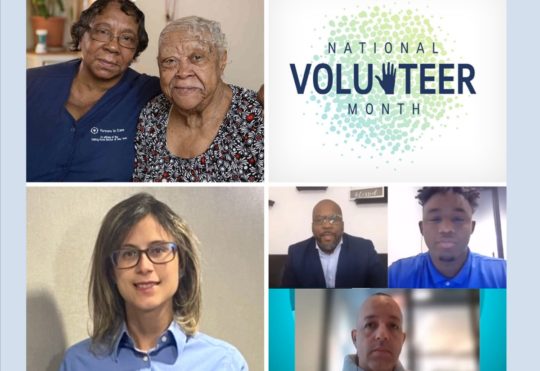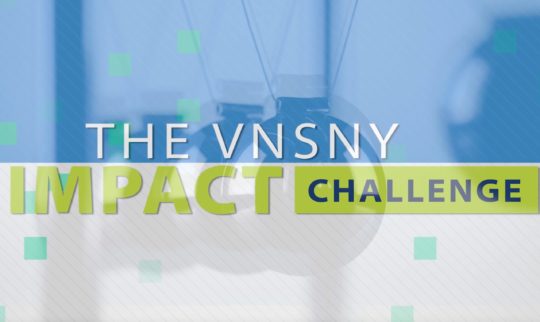Happy National Social Work Month! 10 Interesting Facts About VNSNY’s Social Workers
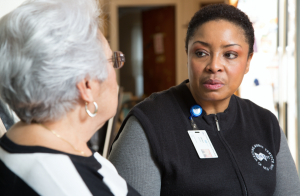
VNSNY CHOICE Social Worker Sandra Thomas with a member family caregiver.
1) Social workers are essential to the care management of our patients and members.
![]() VNSNY social workers are an invaluable part of numerous programs across Provider Services as well as within all of the plans offered by VNSNY CHOICE, providing counseling, access to resources and other critically important services to patients and members in each of New York City’s five boroughs as well as Nassau, Suffolk and Westchester counties. “In bringing their special skills and expertise and experience to their care teams, social workers provide a perspective that really focuses on psychosocial factors and how those are impacting the individuals we’re working with,” notes Jeri Goodman, Social Work Manager for VNSNY Home Care, which has approximately 45 social workers.
VNSNY social workers are an invaluable part of numerous programs across Provider Services as well as within all of the plans offered by VNSNY CHOICE, providing counseling, access to resources and other critically important services to patients and members in each of New York City’s five boroughs as well as Nassau, Suffolk and Westchester counties. “In bringing their special skills and expertise and experience to their care teams, social workers provide a perspective that really focuses on psychosocial factors and how those are impacting the individuals we’re working with,” notes Jeri Goodman, Social Work Manager for VNSNY Home Care, which has approximately 45 social workers.
2) Altogether, VNSNY has over 320 social workers.
The large majority of these social workers work for VNSNY full time, while the rest are employed on a per diem or part-time basis. “Our combination of full time and per diem social work staff gives us added flexibility, allowing us to provide services across a very broad area and extending our availability to evenings and weekends,” explains Jeri. “It also enables us to operate with a high level of cultural competence and language capacity in serving diverse communities.”
3) All of VNSNY’s licensed social workers have earned a Master’s degree in Social Work.
 Every one of VNSNY’s licensed social workers has gone to graduate school and done supervised field placements in various settings. Many have gone on to earn specialized certifications as well. Once in the workforce, New York State also requires that all licensed social workers keep their skills updated by taking 36 hours of continiuing education every three years.
Every one of VNSNY’s licensed social workers has gone to graduate school and done supervised field placements in various settings. Many have gone on to earn specialized certifications as well. Once in the workforce, New York State also requires that all licensed social workers keep their skills updated by taking 36 hours of continiuing education every three years.
4) About two-thirds of VNSNY’s social workers work in Community Mental Health Services (CMHS).
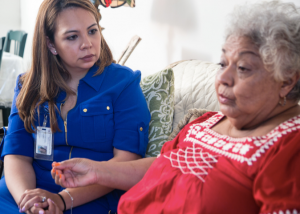
Andrea Wang-Castaneda, Social Worker for the Bronx CMHS Geriatric Program.
CMHS employs the lion’s share of VNSNY’s social work staff—over 240. Many are psychiatric social workers, drawing on their counseling and mental health training to treat clients, both adults and children, in various CMHS programs. “The contribution our social workers make to the well-being of our patients is enormous,” says Neil Pessin, Vice President of Community Mental Health Services. “They’re instrumental in helping individuals and families access care and benefits and helping them adhere to that care—offering counseling and advocacy, and taking a holistic approach that focuses on patients’ whole lives, including all their health care needs as well as their social determinants of health.”
5) Hospice also has a large share of social workers, with more than 35.
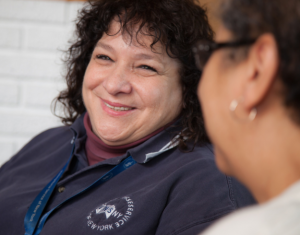
Marilyn Dos Santos, Hospice Social Worker.
Social workers with VNSNY Hospice interact with virtually every hospice patient at some point, providing emotional and practical support for both patients and their families. This includes reassuring them and helping them manage emotionally, and encouraging families to share their feelings with each other as they deal with changes related to their loved one’s condition. “I always tell patients that in hospice we work as a team,” says Hospice social worker Marilyn Dos Santos. “The nurses help them with the stress inside their bodies, and I help them and their family members cope with the stress outside their bodies. I help them adjust to what’s going on and give them a sense of control.”
6) There are over a dozen social workers serving VNSNY CHOICE plan members.

Kathleen Wolfe, Director, VNSNY CHOICE Social Work and Behavioral Health.
The social work staff at CHOICE can be found in CHOICE MLTC, which has several full-time social workers dedicated to meeting the needs of MLTC members; CHOICE FIDA, which employs a number of social workers as medical managers; and CHOICE Social Work and Behavioral Health, where social workers work with all non-MLTC CHOICE members to link them to needed social resources and ensure that any behavioral health issues are being cared for.
7) Social workers are experts at navigating bureaucracies.
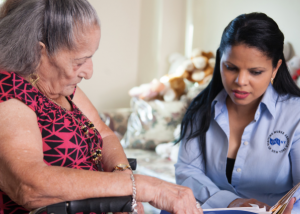
Kenia Alcantara, Social Worker for Home Care.
For VNSNY social workers, advocating for their clients and helping them obtain access to various government programs and benefits is often a daily part of their job. Social workers not only have to navigate bureaucracies, but they have to do it swiftly. “The key to successful social work is creating an alliance, so that the client knows we are there to assist,” says Kenia Alcantara, a social worker with VNSNY Home Care.
8) Social workers are an important bridge to behavioral and mental health care.
 As part of their scope of practice, social workers may refer individuals for behavioral health treatment or provide this treatment themselves. This capability is often called on not only by CMHS social workers but also by the social workers at VNSNY CHOICE, who frequently assist plan members in obtaining treatment for depression, schizophrenia, and other psychiatric conditions, and by the medical social workers in VNSNY Home Care, who focus on the connection between medical conditions and mental health issues and help connect patients with ongoing behavioral health resources.
As part of their scope of practice, social workers may refer individuals for behavioral health treatment or provide this treatment themselves. This capability is often called on not only by CMHS social workers but also by the social workers at VNSNY CHOICE, who frequently assist plan members in obtaining treatment for depression, schizophrenia, and other psychiatric conditions, and by the medical social workers in VNSNY Home Care, who focus on the connection between medical conditions and mental health issues and help connect patients with ongoing behavioral health resources.
9) Social workers hold numerous administrative positions at VNSNY.

Social Worker and Manager of the Chinatown NNORC, Hing Lin (Helen) Sit.
The manager of VNSNY’s Neighborhood Naturally Occurring Retirement Community (NNORC) in Chinatown, the director of the VNSNY CHOICE Adult Day Center in Queens, the Division and DSRIP Projects Manager and the Director of Program Operations at CMHS, the Director of ESPRIT Medical Care, VNSNY’s Director of Government Grants, and the Vice President of Hospice Operations—all are licensed social workers!
10) Social workers are some of the most empathetic people you will ever meet.
“As social workers, very often we’re working with people at a vulnerable point in their lives, so we have to be able to quickly establish a warm, supportive connection,” says Jeri. “In some cases, we’re doing that in the individual’s home. Other times, we’re out in a community site, or we’re providing services in an office or over the telephone. But wherever we are, the heart of what we’re doing involves establishing a rapport with that individual or family so that we can really listen and understand what they need.”
